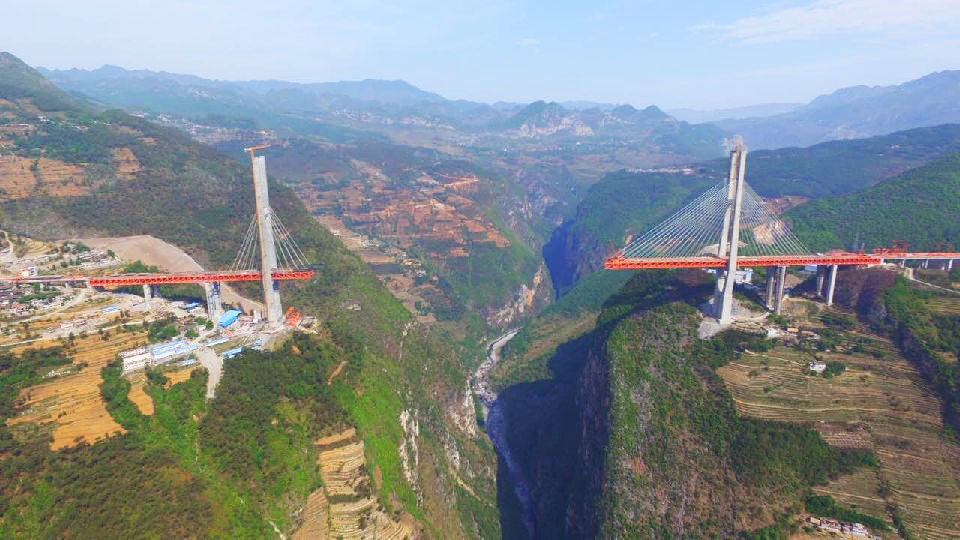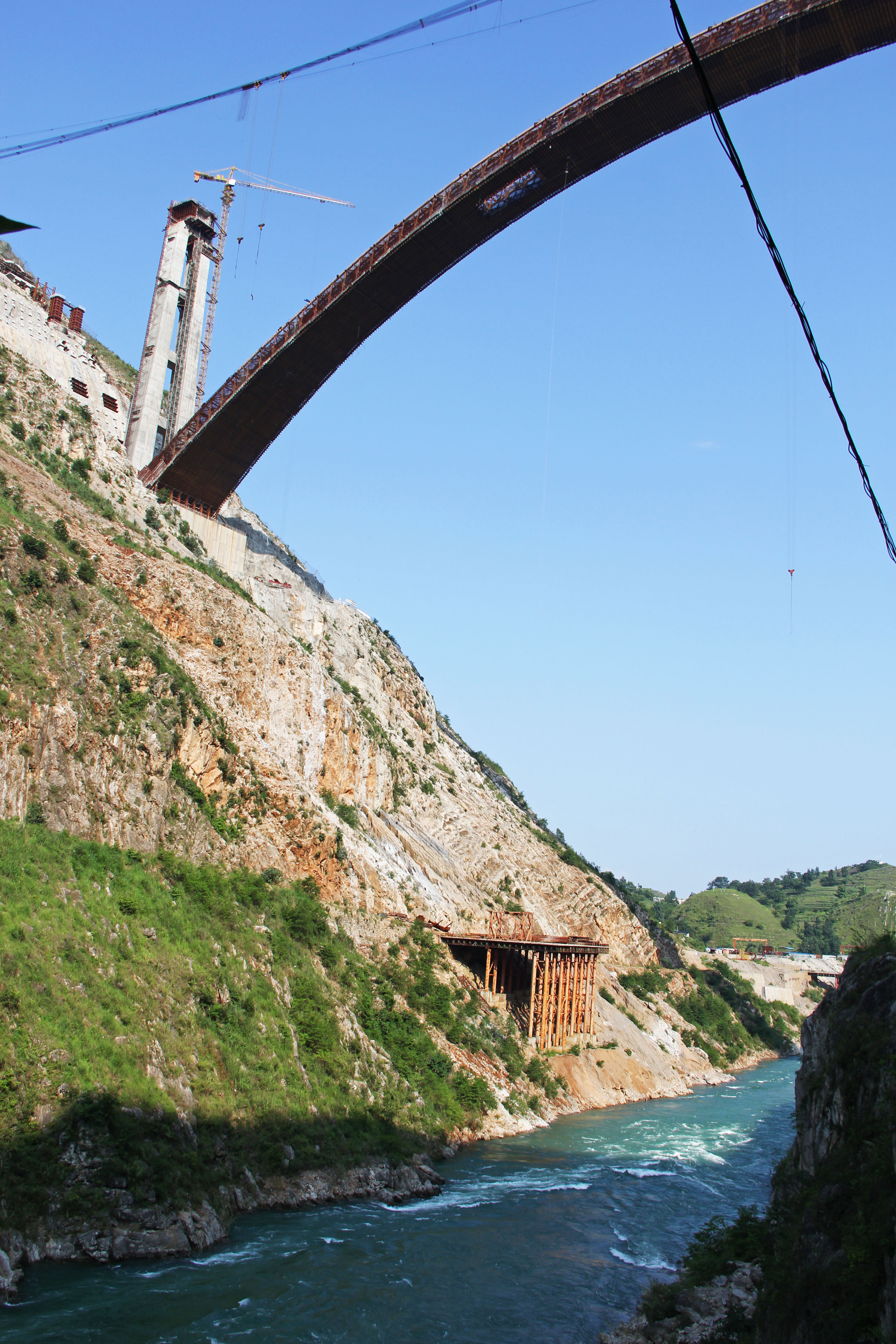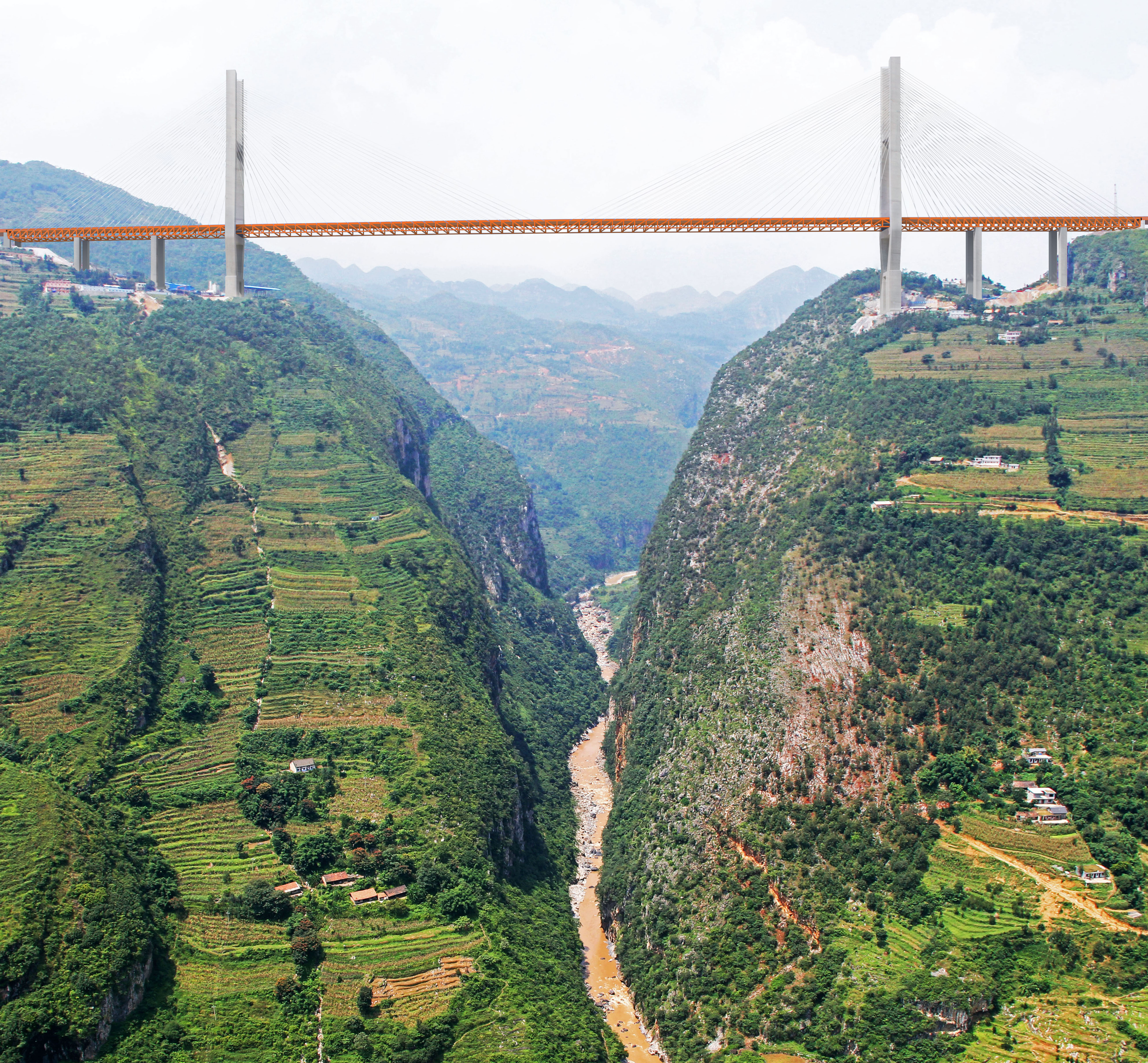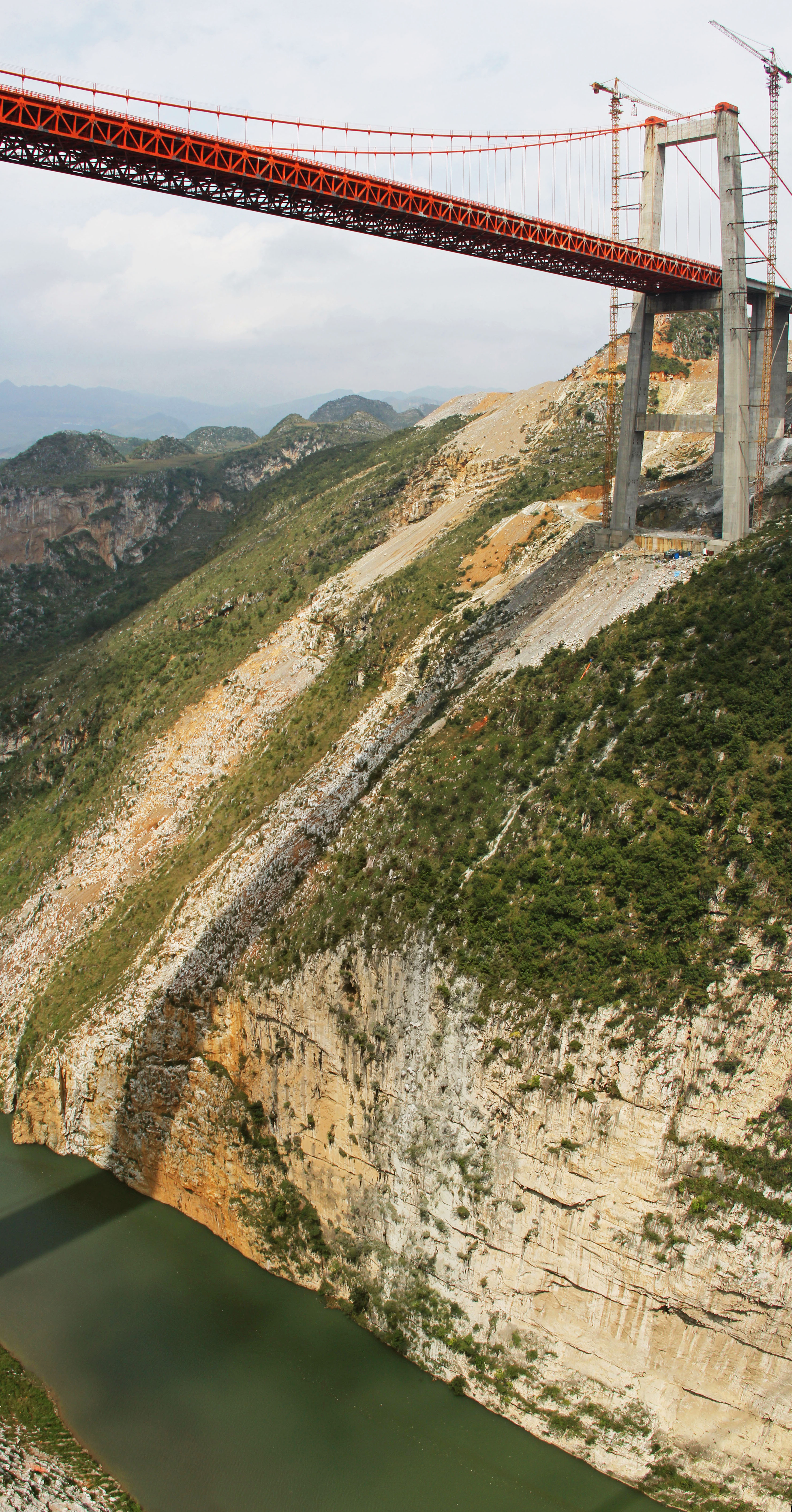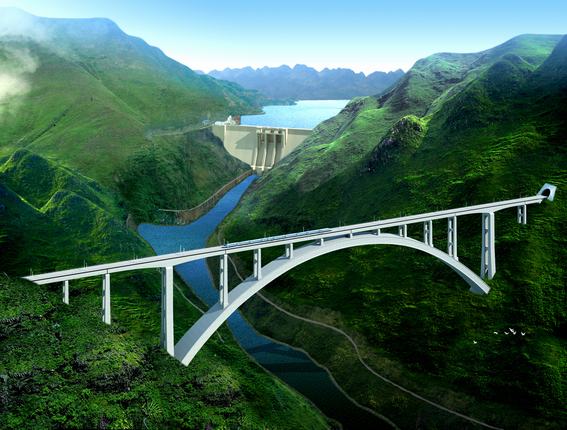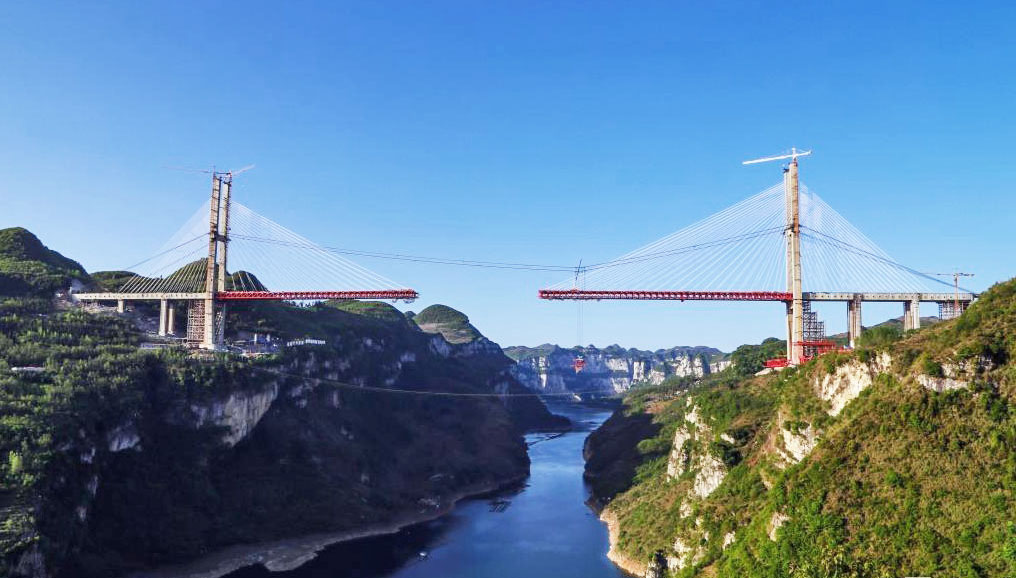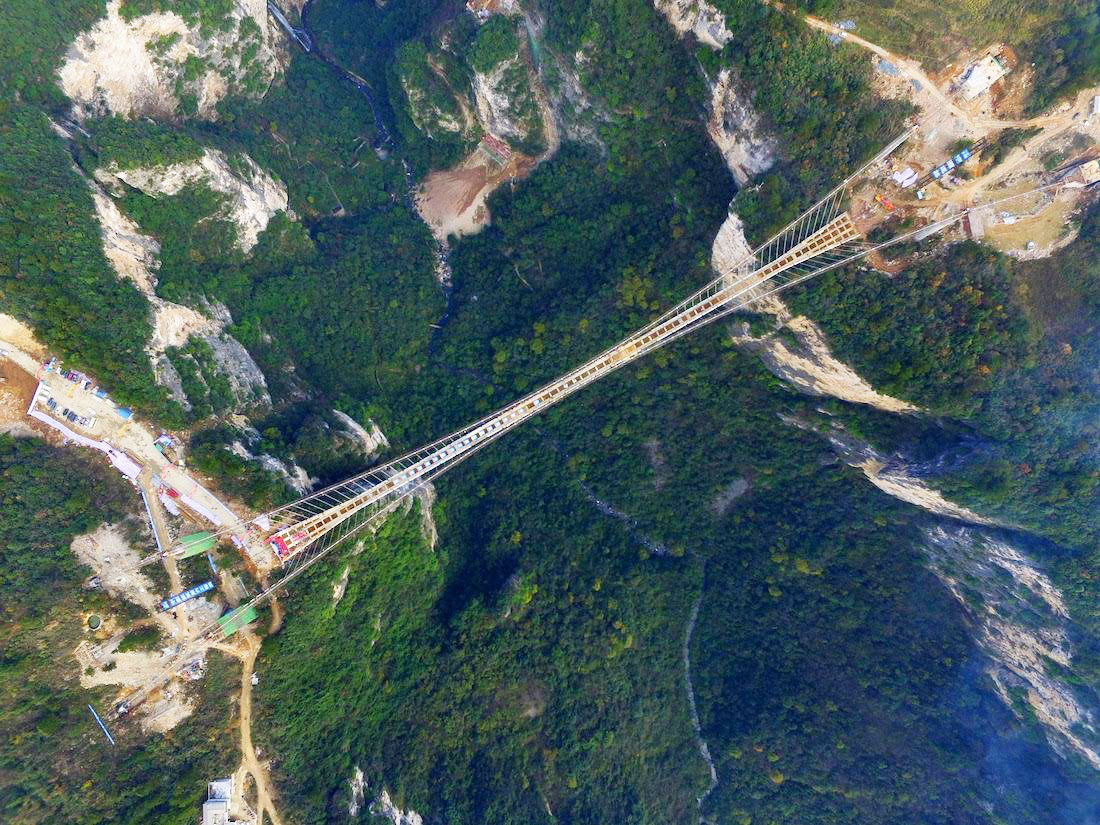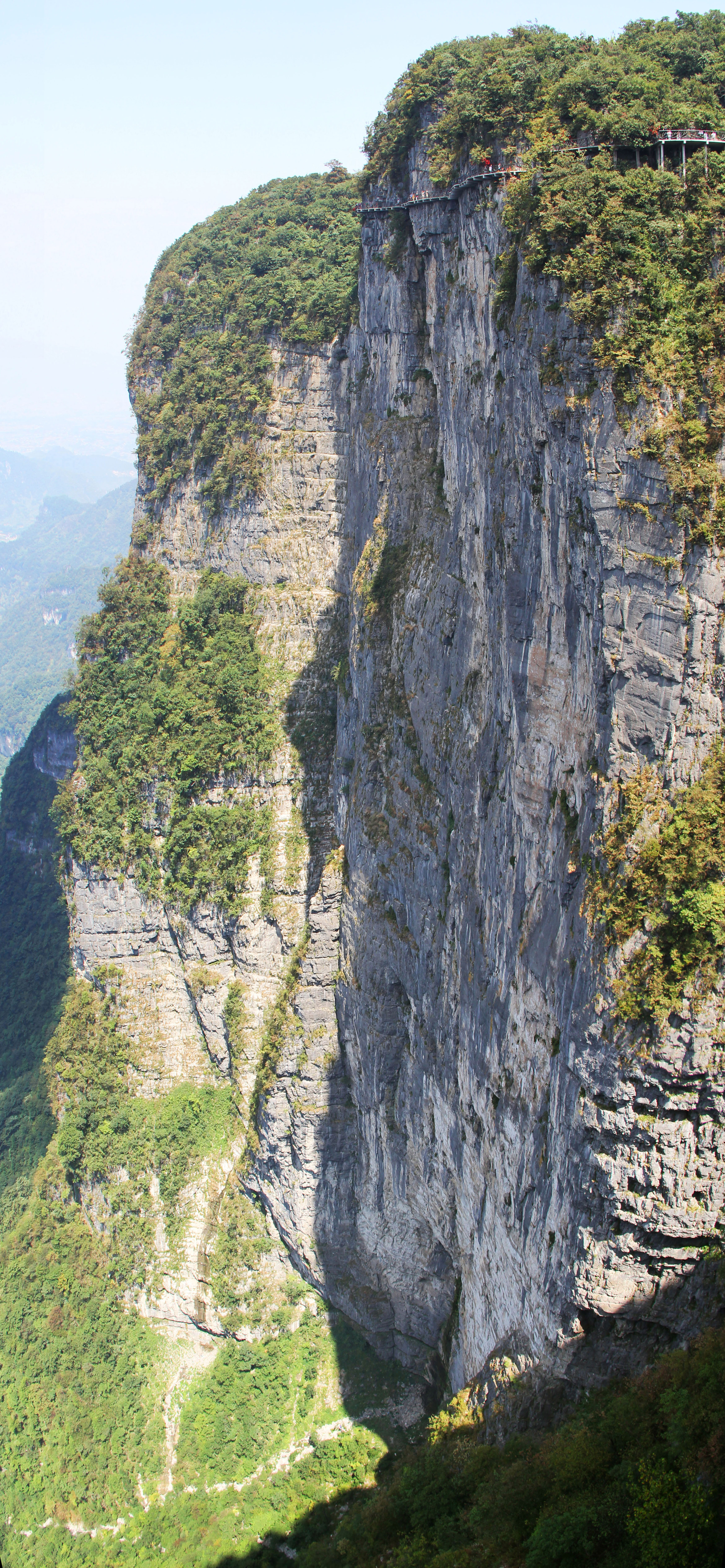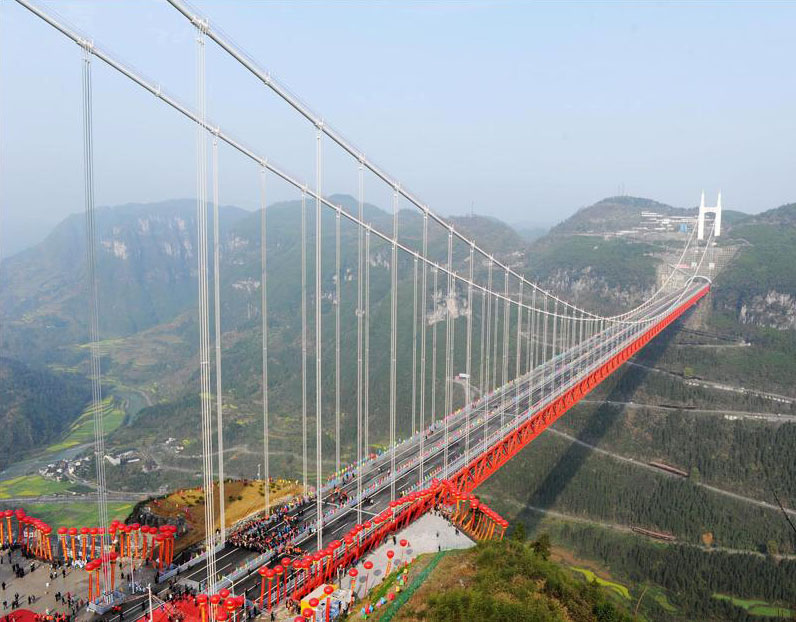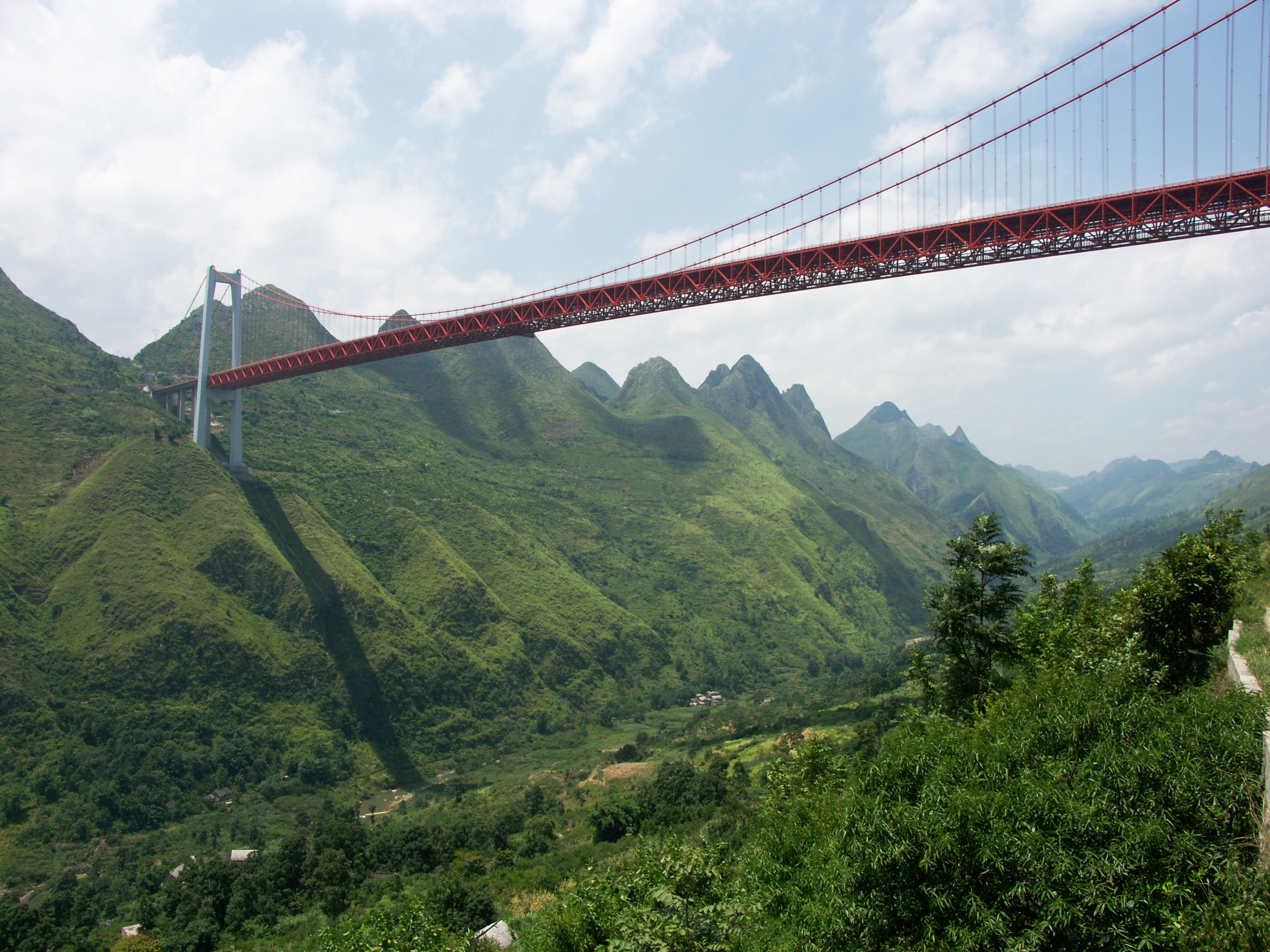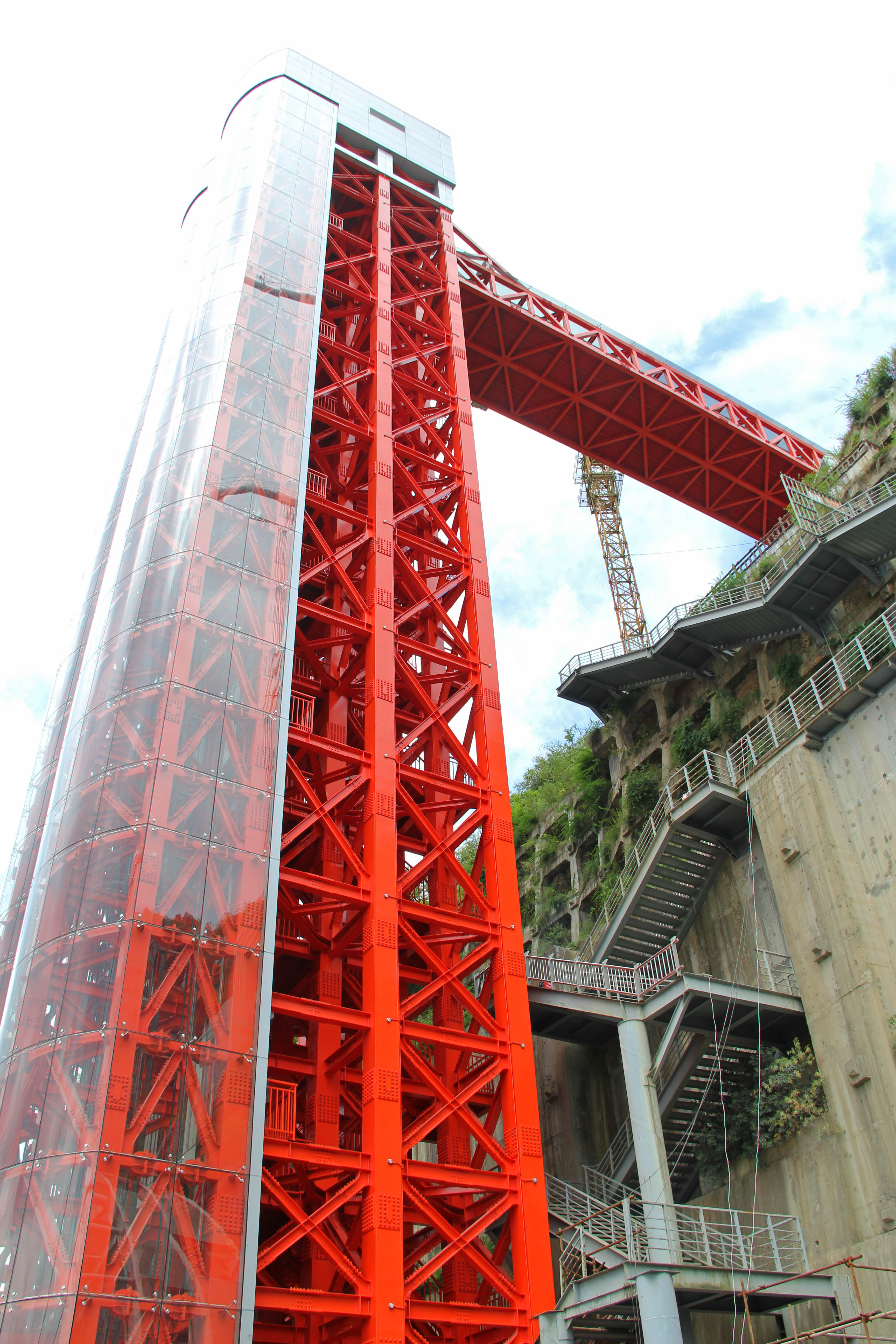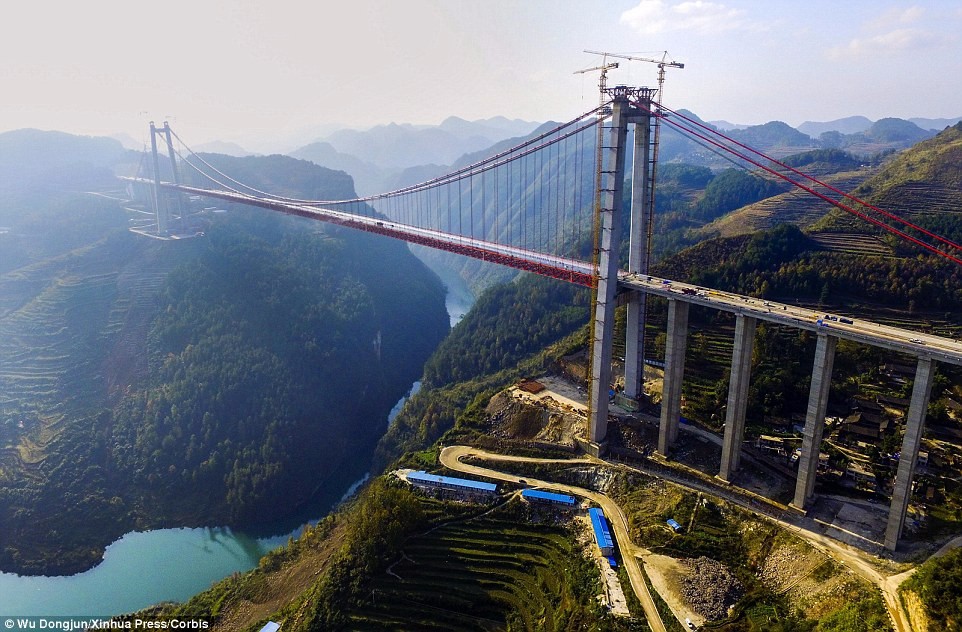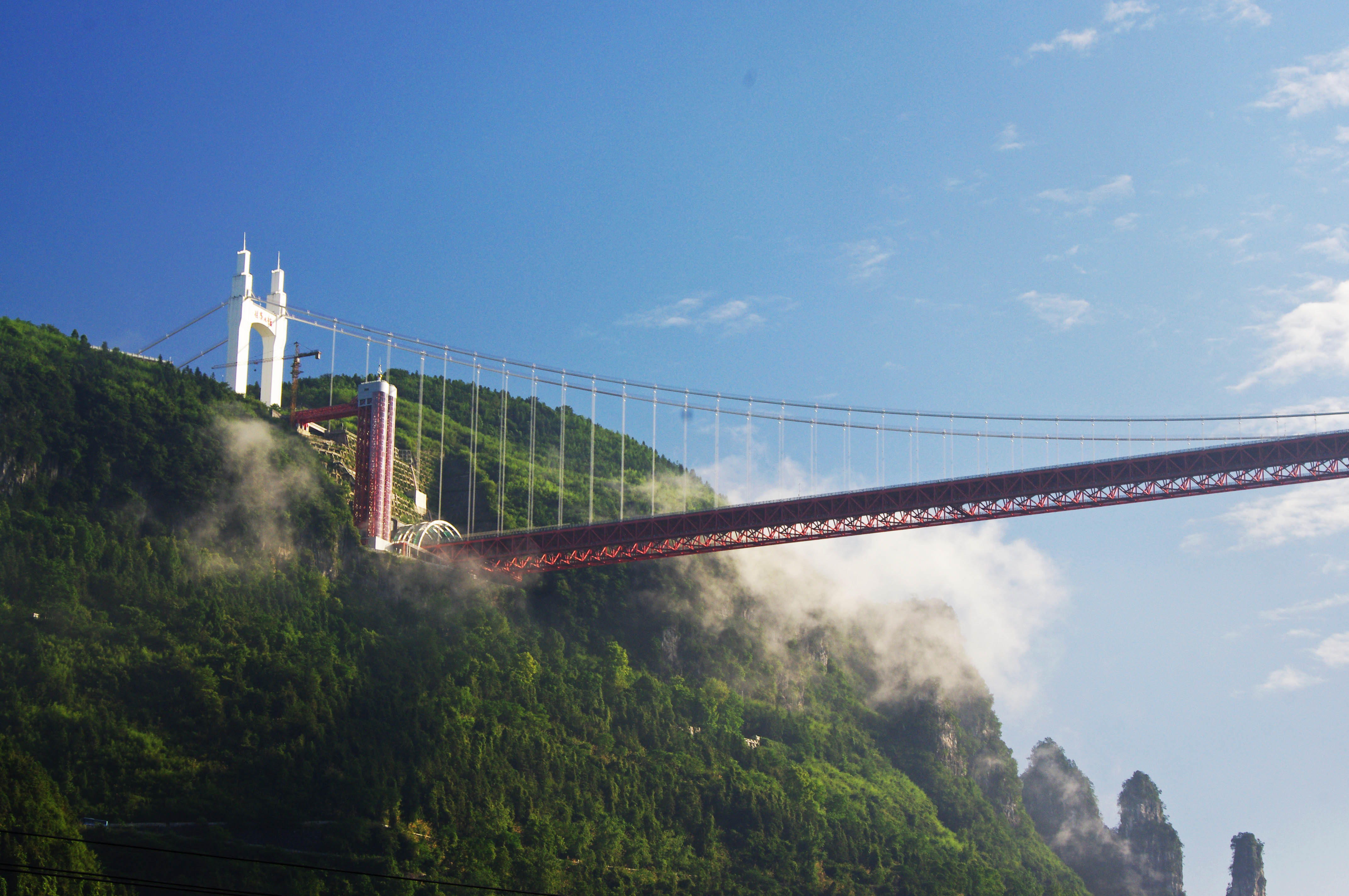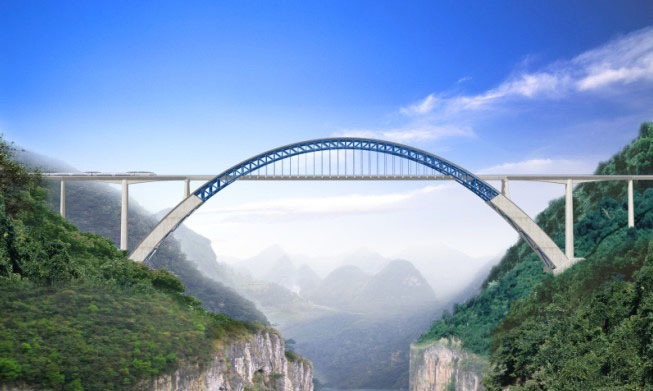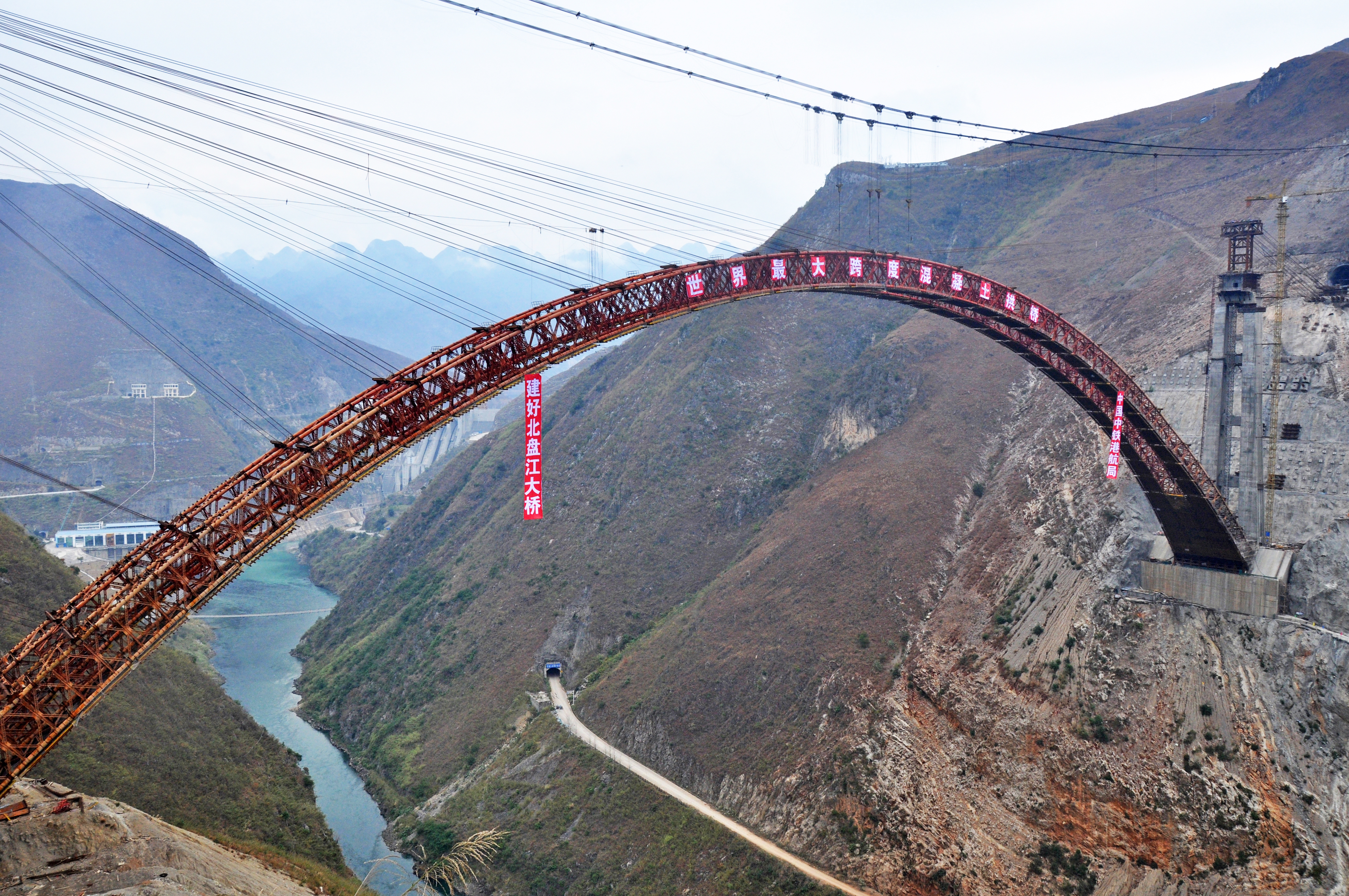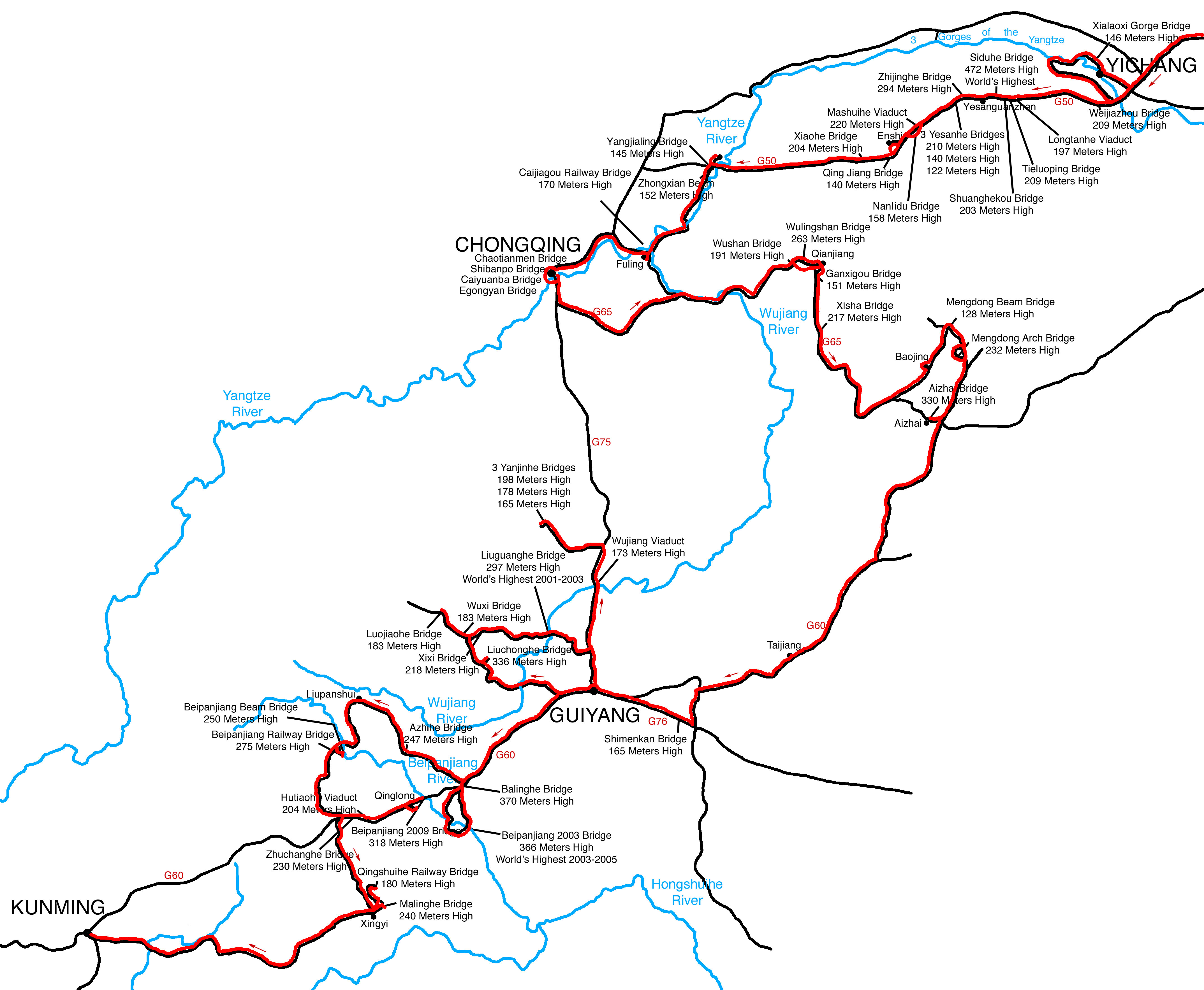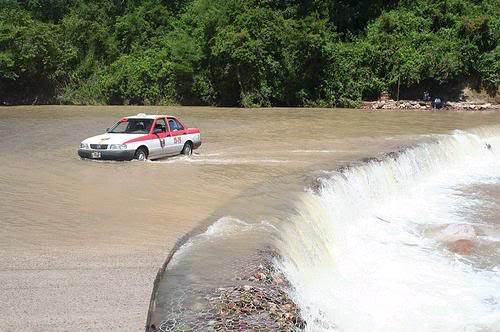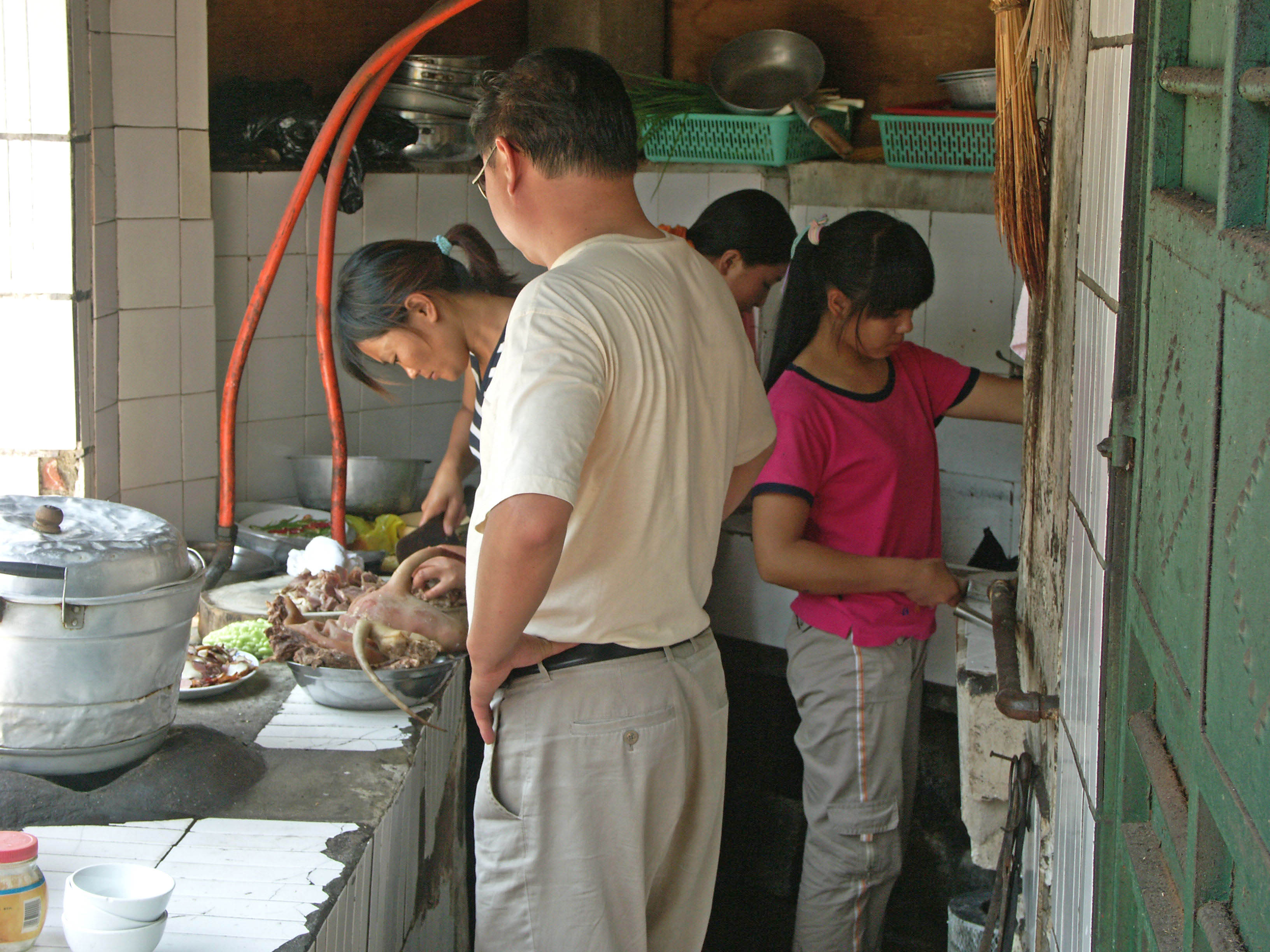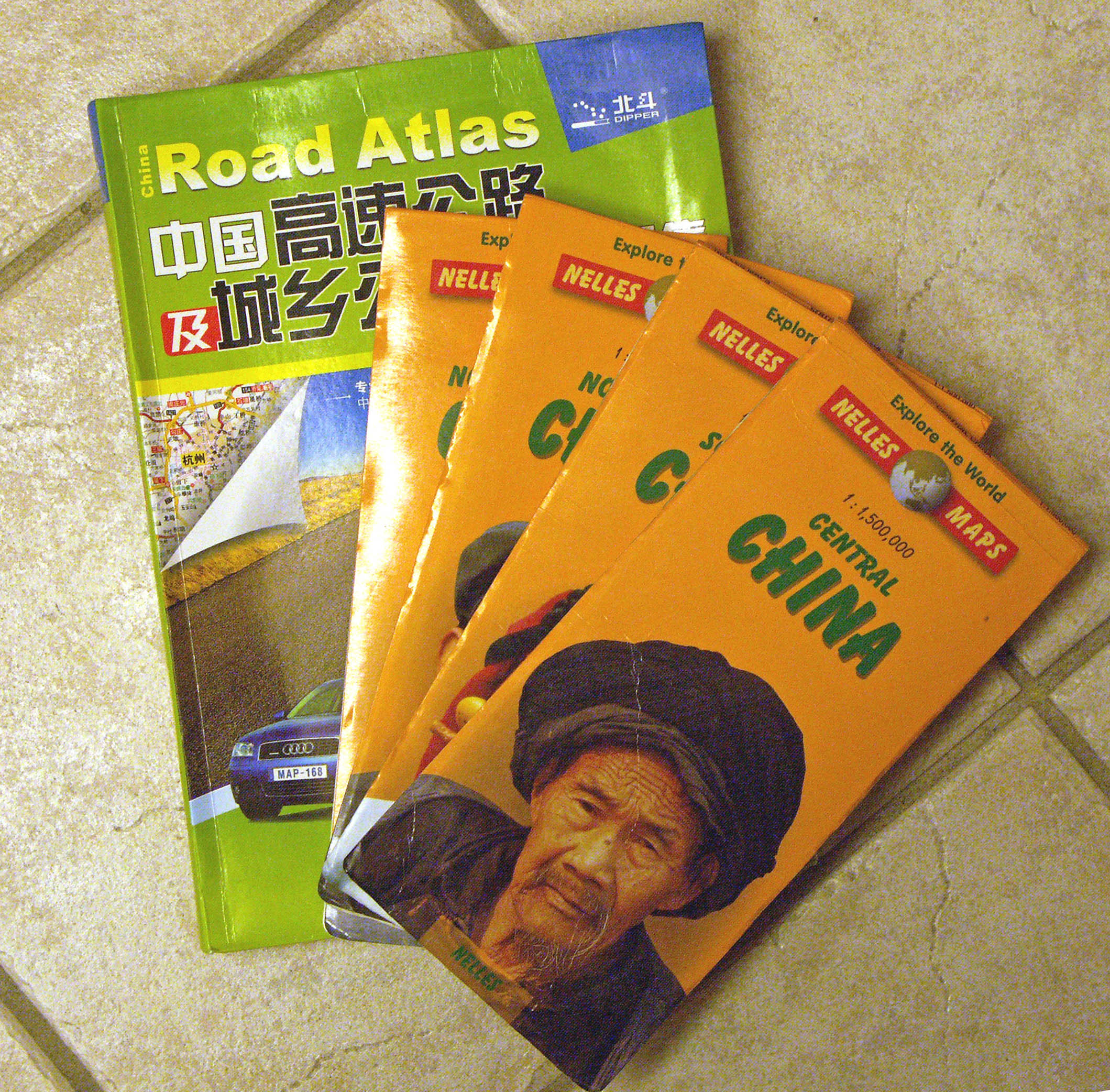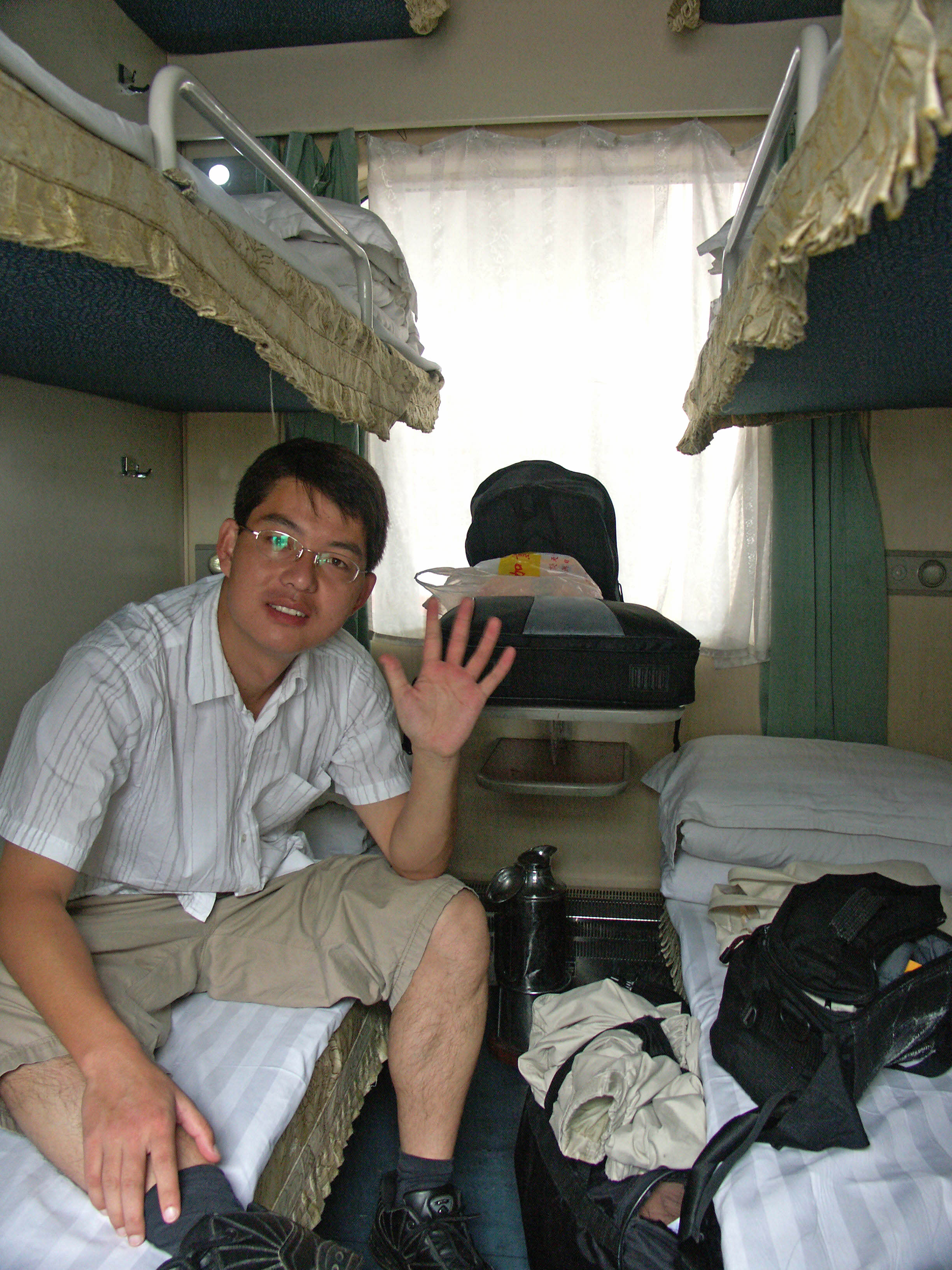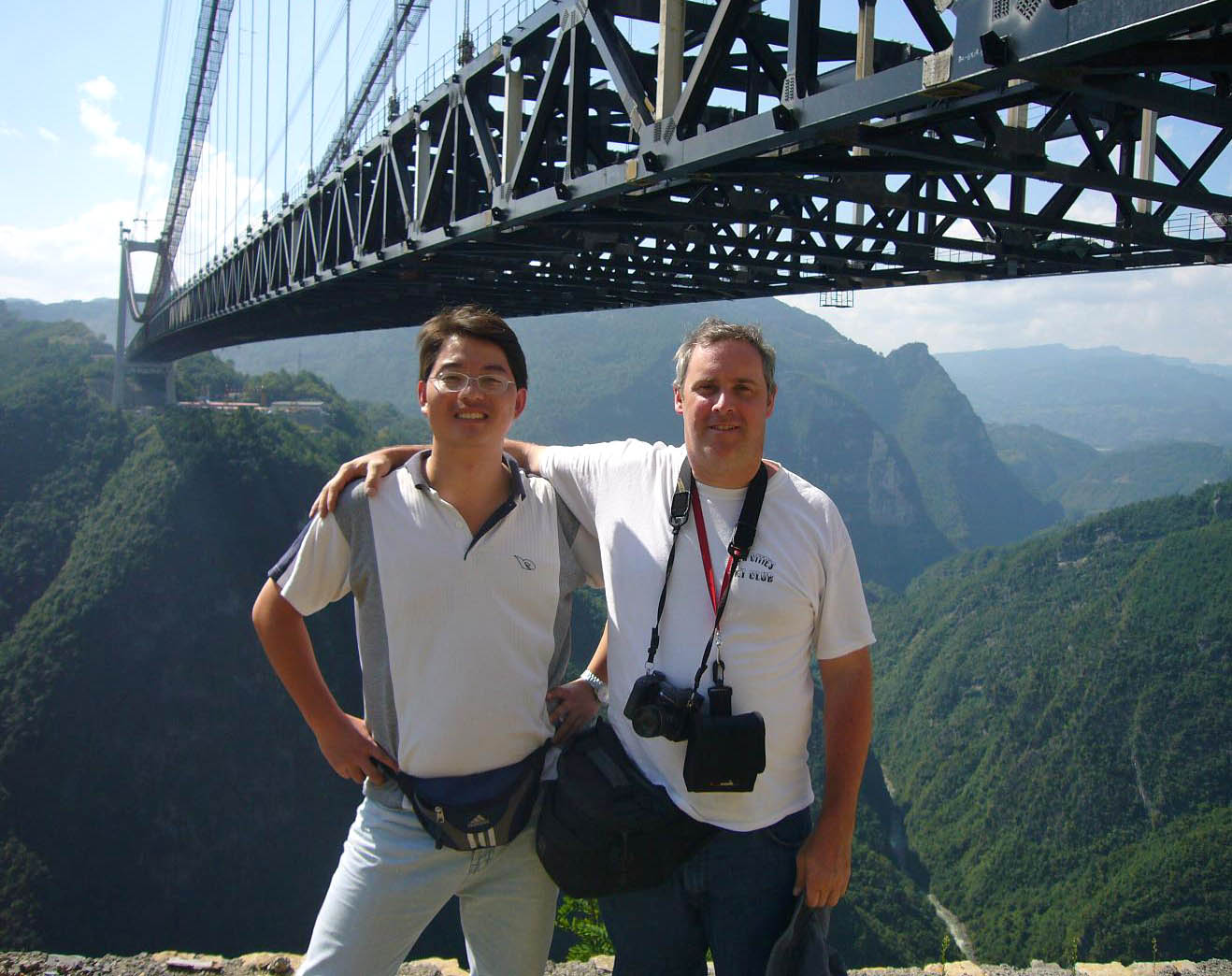China 2017 Trip
Come Along On Our 7th Annual Bridge Trip To China
July 1 - July 18, 2017
Our 7th annual High Over China Bridge Tour is now official with plans to visit over 20 of the World's Highest Road and Railway Bridges including walkway tours of 5 of the world's highest public and private road decks including the World's Highest Road Bridge and the World's Highest Footbridge.
For 2017 we will see a big return of large suspension bridge visits including construction site tours of the spectacular new Tiger Leaping Gorge / Jinshajiang Hutiaoxia spans in Yunnan Province. Like in recent tours, this new tour will be geared as much as possible towards bridges that are under construction with on-site construction tours of at least 10 super spans in various stages of completion that range in height from 250 to over 500 meters high. The crown jewel of these tours will be an amazing visit to the 565 meter high Beipanjiang Duge Bridge - The World's Highest Bridge ever built. We will also see the nearly completed tower of the giant new Pingtang viaduct that will stand 328 meters making it the second tallest bridge structure on earth.
In addition to road bridges, the trip will include tours of 6 of the highest and most spectacular railway arches ever built including the Beipanjiang Qinglong high speed railway bridge with the longest span concrete arch ever built and the Xixihe Railway Bridge with its newly completed arch halves waiting to be rotated out over the gorge in a method not seen on a high bridge since the Chinese first tried it back in 2001 with the Beipanjiang Shuibai Railway Bridge. The trip will only be open to a maximum of 6 people as we will be traveling in one oversized SUV. This is no chartered bus trip for a group of 50 people looking to peer out a window to snap a quick photo of a bridge but a gathering of adventurous bridge fanatics who don’t mind a journey off the beaten path.
Our 7th annual bridge trip will follow the pattern set with the 2011, 2012, 2013, 2014, 2015 and 2016 High Bridge Trips with a small group of bridge fans meeting in Shanghai before a short flight to Western China's famous tourist spot of Zhangjiajie. The amazing national parks of Zhangjiajie will include a special visit to the new Zhangjiajie Glass Footbridge with the highest public bungy drop in the world at 250 meters.
Expect to smell, touch and feel these bridges in a way you could never do in Europe or the U.S. Prepare for some dust, dirt and a lot of sweat.
You will visit more than 20 of the world's highest bridges on this trip
including half of the world's 10 highest road bridges,
6 of the world's 10 highest rail bridges,
a special visit to the highest footbridge ever built,
and so much more!
The 7th ever HighestBridges.com Organized Bridge Trip to China includes:
• All Ground Transportation via one 8-seat SUV for almost 2 weeks
• 12 Nights of Lodging from Sunday Night 7/1 through Friday Night 7/18
• Flight from Shanghai to Zhangjiajie in Western China.
• Three meals per day plus snacks & drinks
• Construction tours at 10 bridges including Jinshajiang Hutiaoxia road and railway, Xixihe Railway, Yelanghe Railway, Yachi Railway, Xianghuoyan, Pingtang, Lancanjiang Railway, Nujiang Railway and Wujiang Nanmudu.
• Special walk across the highest and largest footbridge in history.
• Special catwalk tours over 300 meters high within the Aizhai, Balinghe and the two great Beipanjiang gorge crossings.
• Exclusive 2017 Trip Photo Album posted on this website.
- 2011 High Bridge Trip Photo Album
- 2012 High Bridge Trip Photo Album
- 2013 High Bridge Trip Photo Album
- 2014 High Bridge Trip Photo Album
- 2015 High Bridge Trip Photo Album
- 2016 High Bridge Trip Photo Album
• All for just $4,450!
• You can reach me at eric@highestbridges.com
2017 China Bridge Trip Sampler
Bridge highlights will begin with visits to Zhangjiajie Glass Bridge - the highest footbridge on earth. A special tour will be taken to multiple vantage points from the bottom of the gorge as well as from the cliffs on both sides. You can also take the highest public bungee jump in the world from the glass deck nearly 250 meters above the river surface.
The entire Zhangjiajie Grand Canyon park is a creation unlike any other in China with a mountain elevator, caves, waterfalls and a boat ride along the river. We will be meeting with the owners and creators of this private paradise that will be luring over a million people a year.
The second day of the tour will be just as spectacular with a visit to the incredible gondola ride up to the top of Tianmen Mountain where the world's highest cliffwalks reside with drops of over 300 meters. A trip along the 99 turns bus road leads to the giant 150 meter high cliff cave hole and the entrance to the world's highest escalator gain of 300 meters built inside the mountain.
On our third day we visit the giant Mengdonghe arch bridge with a concrete filled steel tubular span
of 268 meters and a height of 250 meters. Our visit will coincide with the completion of the
soaring main arch composed of thin, hollow tubing that will be stiffened with concrete.
In the afternoon we tour Aizhai Bridge, currently the longest span high bridge in the world with a tower to tower gap of 1,196 meters, nearly as long as the Golden Gate Bridge. Probably the most beautiful high bridge in all of China, the Aizhai Bridge made media headlines when it opened in 2012 on the new G65 expressway in Hunan Province as the world's highest tunnel to tunnel bridge span. Located over a protected scenic spot, the towering rock formations and cliffs of the DeHang canyon have made the crossing a new tourist destination and in 2015 the walkway inside the huge truss opened to the public for the first time, allowing unprecedented views of the deep abyss below.
The new Beipanjiang High Speed Railway Bridge entered the record books when it becomes the world’s highest railway bridge at 295 meters, toppling the 15-year old record long held by the Beipanjiang's own 2001 steel arch bridge. Even more amazing, the new Beipanjiang high speed crossing will be the longest concrete arch on earth with a clear span of 445 meters, breaking the record held by China's own Wanxian Bridge across the Yangtze River.
Our adventure continues west into Guizhou with a stop by the giant Qingshuhie suspension bridge with a massive main span of 1,130 meters - the 2nd longest span high level bridge in the world after Aizhai but the longest if measured along the actual suspended truss deck. The giant towers of Qingshuihe are so tall at 755 feet they exceed even the Golden Gate Bridge.
North of Guiyang we encounter the beautiful red arch of the Xianghuoyan Bridge under construction with a concrete filled span of 984 feet and a height of 574 feet. A giant 260 meter long Indiana-jones style footbridge next to the arch will offer amazing vantage points to see the two halves of the arch rising up from their abutments.
After lunch our attention turns to the massive concrete beam of Yangshuihe with a central prestressed span of 230 meters crossing approximately 827 feet above the river. Our tour will view the nearly finished central gap almost closed from another super span footbridge of over 260 meters and 125 meters high
East of Bijie are two high speed railway arches that will be epic in scale when they become operational in 2017. The first is the Xixhe 255 meter high arch span that will be unique as the two halves will be under construction on scaffolding high up on the edge of the canyon waiting to be rotated out over the canyon. The nearby Yachi Railway Bridge will be even more spectacular with a central span of 436 meters that rank among the longest span railway arches ever constructed. The highline towers of the Yachi Railway Bridge are the tallest ever erected for a bridge anywhere in the world at over 170 meters.
With a deck almost 200 meters higher then Mexico's Baluarte, the Beipanjiang Bridge Duge is going to turn heads around the world with its drop of over 500 meters supported by towers 269 meters tall. We will be the first foreigners to walk across the deck just days after they close the two sides of the bridge 565 meters above the river.
The highest bridge in the world upon its opening in late 2003, the 366 meter high Beipanjiang Huajiang highway bridge became the second Chinese span in just two years to take this honor. The first was 2001’s Liuguanghe bridge. In addition, the Beipanjiang became the first bridge to break the 300 meter height thresholds as well as the first suspension bridge in the world to surpass the height of Colorado’s Royal Gorge bridge after a 74-year reign. The span is unique for having an extremely thin .6 meter thick prestressed concrete slab deck and cable suspenders just 5 meters apart.
On our sixth day the trek heads to Northern Guizhou Province to our next giant arch, the twin track high speed Yelanghe Railway Bridge with a herculean concrete main span of 1,214 feet - larger then the Hoover Dam Bypass Bridge over the Colorado River.
Heading west from Guiyang along the new Kunming highway will be a stop to a bridge that will simply take your breath away - the crossing of the Balinghe. Towering 370 meters, this is currently the highest road bridge in the world to allow pedestrians to walk across. The new visitors center leads to an elevator that takes visitors up into the truss where we will be able to walk inside its full length.
The Wujiang River has more high bridges across it then any other river on earth. None will be higher then the giant 580 meter cable stayed span of the Liuguanghe Bridge with impressive towers 248 and 236 meters tall. The deck will be half complete during our visit with the steel deck sections cantilevering over 300 meters above the water.
Our afternoon bridge is no less impressive as Yachi Bridge is the longest span high level cable stayed bridge in the world with a main span of 800 meters hanging over 300 meters above the great Wujiang River. The side spans are half the length of the center span promting the engineers to create a first-ever weighted concrete deck with circular steel anchors.
Our final day will be in and around the large city of Liupanshui high in the mountains of Guizhou. Here one of the highest and most spectacular suspension bridges crosses the upper reaches of the south fork of the Wujiang. Known as Dimuhe, this suspension bridge leaps between cliffs in a single bound of 1,765 feet. Later in the afternoon we all travel to nearby Liupanshui City Airport for a 3 hour flight to Shanghai.
A total of 2 to 4 people will be on the trip plus myself, an interpreter and a driver. As trip planners and organizers, we will be taking care of everything for the 2 to 4 additional guests. This includes the round trip air fare from Shanghai to Western China as well as the hotels, meals and car travel. We are hoping to pair single people together in hotel rooms but if you don’t mind the additional cost you can have your own private room for the duration of the trip. With each spot being filled on a first-come, first-served basis, you might be out of luck if you wait too long!
This trip is not for the timid or physically challenged. We will occasionally be traveling down into the canyons beneath these bridges on dirt roads that are often bumpy and dusty. There will be short but occasionally strenuous hikes down paths to reach spectacular viewpoints. At the end of the day you will be a little sweaty, dirty and wanting a hot meal, a hot shower and a cool hotel room to sleep in.
Feel free to contact me with any questions you may have at Eric@HighestBridges.com. The price of this nearly 2-week trip is under 4,000 dollars which is an incredible bargain, so don't be shy about contacting me. This trip can only happen if at least 4 people sign up!
Partial List of 20 Highest Bridges on the Tour
- Aizhai Bridge
- Beipanjiang Bridge Duge
- Yachi Railway Bridge
- Yachi Bridge
- Puli Bridge
- Jinshajiang Bridge Hutiaoxia
- Beipanjiang Railway Bridge Qinglong
- Yelanghe Railway Bridge
- Jinshajiang Railway Bridge Hutiaoxia
- Xixihe Railway Bridge
- Qingshuihe Bridge
- Dimuhe Bridge
- Pingtang Bridge
- Sunxihe Bridge
- Wujiang Bridge Nanmudu
- Balinghe Bridge
- Zhangjiajie Grand Canyon Glass Footbridge
- Lishuihe Bridge
- Xianghuoyan Bridge
- Lancangjiang Railway Bridge Darui
Want To Create Your Own High Bridge Trip?
Regardless of whether you want to be a part of my bridge tour or head off to Western China on your own, you need to understand up front that you cannot drive to these high bridges yourself. Since you must hire your own guide and/or driver, the following travel advice is for anyone who might be thinking about planning their own high bridge trip through Western China. Much of this advice also applies to those who might be coming on my 2015 trip.
With so many spectacular, high bridges in one region of the world, many will be wanting to hop on the next plane to China and begin a whirlwind tour of these “high”ways in the sky. Before you run out and buy a ticket, there are some very informative suggestions you need to learn about. These are not just tips but very important warnings that can make the difference between a once in a lifetime experience or an unforgettable nightmare.
A visit to the rural mountains of Western China is a world apart from a trip to a modern city like Shanghai, Beijing or Hong Kong. The big city hotels and western style restaurants that cater to English speaking tourists are not to be found in Western China outside of a handful of large cities. The high bridges located within this web site are far away from these big cities in mountainous regions of mostly poor farmers, many who have never seen a foreigner. This means that you will have to be resourceful and adapt to a rough environment that is more like a third world country where access to reliable transportation, food and lodging cannot be taken for granted.
First, do not even think of driving or renting a car in China’s western provinces. You can only visit these bridges by hiring a taxi driver for every day you are there. The mountain roads are incredibly dangerous, requiring an experienced driver to dodge any and every imaginable form of human and animal life as well as reckless trucks, automobiles and motorcycles. These assaults will come at you from every direction. When you are on these secondary roads, your driver is going to be using his horn constantly. Driving-by-horn in the mountains is not just an option but an important survival tool. To avoid colliding with people, bicycles and animals, a constant “beep” is required to warn each and every one of them. For a taxi driver, the use of a horn is second nature - for you it is not. Much of the time you will be on unpaved dirt roads filled with potholes, rocks and mud. Trucks and buses coming in the opposite direction are going to pass slower traffic by coming head on into your lane, forcing you to come to a sudden stop. If you did get in a collision, in a very real sense, you would be at fault even though the other driver came into your lane! Other times you will be stuck behind a slow moving truck, trapped in a cloud of dust and exhaust thicker than a dense fog.
Hired drivers and taxis are good because they know their regions well, they know what roads might be under construction or are washed out, what roads are dangerous and what roads are safe. Outside of the major highways, maps have little or no detail and only Chinese names. The rural sign-age you encounter on local roads will also be in Chinese language if there is even a sign at all.
But even if you could convince a Chinese car rental company to rent you a car and even if you could read Chinese road signs, and even if you could learn to use the horn and dodge oncoming traffic, the most important reason to hire a driver relates to the bridges themselves. You are there to walk across and under the bridges to take photos and experience the scenery. Many of these bridges do not have safe areas to pull over and park. In some cases, your driver will have to drop you off and park further down the highway and wait for you. In other cases you will want him to take you down to the bottom of the bridge on some unknown side road. A personal driver means having no worries about leaving your car on the side of the road with your belongings left unattended. It means no worries about getting lost, and best of all, no worries about getting in an accident. There is also no cost difference. For a little over a $125, you will have your own personal car and driver for the entire day. No insurance papers or damage waivers to fill out, no unforeseen tows or car repairs, no expensive late fees.
Finally, the best reason you might want a driver is food. When you are up in the mountains, you will not be able to stop off at a Denny’s or a McDonalds. The driver will know what places to avoid. He will not shy away from going into the back of the restaurant to check on the quality and trustworthiness of the meat you will be eating and how it will be prepared.
Now that I have convinced you that hiring a driver is the only way to go, you need to be warned that many drivers cannot be trusted and you will have to pick a driver that can be counted on to serve you and not try to steal or rip you off. If you don’t watch out you could find yourself sitting on the side of some mountain road, your taxi driver having taken off with your belongings, never to be see again.
Due to the long distances between these bridges, there might be days you are going to have to bring all of your luggage with you as your one or two day taxi driver is going to be dropping you off in a different city from the city where you hired him in the morning. That means you will have to entrust your belongings with him as you visit the different bridges. As an outsider in these regions, you are going to stick out like a sore thumb. People might want to take advantage of you if you let them.
If you do not have the money to have a travel agent set you up with your own driver for the entire trip then the best person to find you a good taxi driver each day will be the concierge at the hotel you are staying at. They will have a known pool of drivers that they use and the drivers will be less likely to try anything funny. Even so, a driver knows you are unfamiliar with negotiating and so the price you agree on should be clear and well established before you leave. You should expect to pay him extra if the day extends to 14 hours instead of 12 as you had planned or if you drove 600 miles (966 km) instead of 500 (805 km). All of this should be worked out in advance. You should expect to pay him in cash when you get back to your hotel in the evening. If you have to stay overnight away from his city, you will need to pay for his hotel room. You should also expect to pay for his lunch. It is an inexpensive courtesy that may earn you some points if you get back a little late or want him to do something risky like illegally pulling over in the middle of a bridge, etc. And if you had a great day, why not invite him to dinner when you get back to the hotel. I got along with my driver so well in Guiyang, he agreed to come back the next morning and spend two hours showing me another high bridge I had not know of - for free! When you get into the taxi, always snap a digital photo of his license which should be on the dashboard.
The most important thing you can try to bring with you on a vacation to Western China is another person, whether it be your own spouse, a close friend or a hired Chinese guide. He or she can be a second set of eyes as well as someone who can go along with you when you venture down into some unknown gorge to take photos. I visited many of China’s high bridges with an English speaking Chinese engineering student from Shanghai who handled all of the dealings with the taxis and hotels. He made sure every driver was an honest one as well as telling the driver what will be in store for them. Many of these small taxis have low clearances that are unsuitable for such horrible roads and a driver might not want to head into the mountains to have his car get abused for the same money he can make in the city on normal roads. Communicating your desire to go “off-road” is crucial to finding a good match for a driver. Finally, do not ever agree to go along with a taxi driver who wants to “bring his friend along” for the day. Two guys taking you into the mountains or down a back alley could easily be a setup for a rip-off.
Once a good driver is found, your biggest hurdle will be communication. The driver will not know English or any other language outside of Chinese, so you will need to be prepared. Prior to leaving for China, you should print out a full size image of every bridge you plan to visit along with the Chinese and English names also printed on the photo. In addition, be sure to print out any maps from this web site with the location and names of the bridges you want to visit as well as purchasing a China Road Atlas that is available at most airports and bookstores. Also good for planning your entire trip is a fold out map like the ones sold by Nelles that cover the general regions of Central and Southern China. People are very un-knowledgeable about bridges. They don’t know the difference between a suspension or a cable stayed bridge. Photos, names and map locations of each bridge will be your only way to show the driver exactly what bridge you want to visit and its general location. Even so, expect to be frustrated as you will get lost from time to time - ultimately the driver is not likely to know these rural back roads any better than you will. Asking locals for directions will often be your only guide.
Outside of the concierges in the nicer 4 or 5 star hotels in the cities of Chongqing, Guiyang and Kunming, people in the western provinces do not speak English or any other foreign language. There are few hotels in most of the smaller cities and towns in the mountains. For those visiting the West Hurong highway, the cities to stay in are Enshi and Yesanguanzhen. Along the Yangtze River, most of the larger cities have hotels that cater to tourists. You should always plan on getting back to a hotel by the end of the day. Driving at night is generally not safe except on the major highways and in the cities. You can read more at http://wikitravel.org/en/Driving_in_China. Be sure to scroll down to the section titled “Danger”. Remember, for every mile a person travels on a road in China, the likelihood of getting killed is the same as driving 10 miles in Europe or the U.S.
Now that I’ve covered the nasty side of travel on China’s tough roads, I will go over the easy side of travel - the planes, trains and buses. Unlike most countries in the world where you must buy plane tickets in advance, China’s airports are more like bus terminals where you can sometimes purchase a ticket just a few hours before a flight. Even so, large discounts can be had on the web if you book a ticket on line at least a day in advance. All of the airlines can be compared and purchased on http://english.ctrip.com/. This makes it a perfect way to travel between a larger city like Chongqing or Guiyang with some of the smaller cities like Yichang or Wanxian. Instead of spending 5 hours in a bus you can hop between two cities in just an hour.
Buses may be slower than planes but they are the only form of transportation outside of a taxi that can take you to some of the smaller cities and towns that are in the mountains. In addition to easy accessibility, they also tend to run more frequently than planes and trains and are quite comfortable.
Trains are not any quicker than a bus or a taxi but they are incredibly cheap in China and allow you to catch up on sleep or take in the countryside. Train tickets are generally divided into separate classes. The hard and soft seat are the cheapest and most common way to travel but they are often crowded and uncomfortable for long routes. The best is the soft sleeper with only 4 beds to a room and not much more than a hard sleeper where there are 6 beds to a room. Getting a ticket is the most difficult aspect of train travel. Large stations are often crowded and travel during holiday periods should be avoided. You don’t have to worry about eating as all trains have roving trollies and a dining car where cooks can prepare hot Chinese meals. You might want to prepare for the toilets though as they can be dirty and stinky and require you to squat over a hole in the floor, keeping your balance as you try to aim. Finally, expect to bring your own toilet paper - train bathrooms will never have any.
So if you use some common sense and plan out your route carefully, you can have a bridge adventure you will never forget. Just remember that sudden setbacks will come up. Bad weather can come at anytime. Cars, buses and trains break down. Also remember that the advice I have given to you is no substitute for all of the normal, travel related things that you would have to prepare for on any big trip to China that are mentioned in such guidebooks as Lonely Planet or Fodors. The process of obtaining travel insurance, visas, permits and vaccinations are all well described in these books and beyond the scope of this website. Since I have traveled to western China several times, I do have some good contacts with drivers who have visited some of these high bridges and are trustworthy. If you are planning a bridge trip to western China, I will be glad to give you any advice and suggestions.
You can reach me at eric@highestbridges.com


